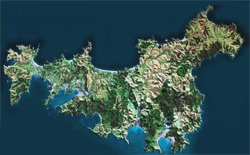Tangata whenua[edit]
Tribal area: Ngati Paoa, Ngati Maru, Patukirikiri. Tangata whenua for the island is Ngati Paoa, one of the tribes in the Hauraki Confederation. The island's marae, however, is Piritahi Marae, a pan-cultural centre established on a city council reserve at the western end of Blackpool. Its long-term chairman and prominent kaumatua was Kato Kauwhata who died on 11 November 2007.
History[edit]
See also Waiheke local history at Auckland City Library Waiheke was probably among the first places to be settled by Polynesian travellers when they first came to Aotearoa/New Zealand some 800 years ago. A natural crossroads on the routes north and south, many of the smaller gulf islands hosted non-permanent communities. On Waiheke and Great Barrier, however, permanent populations developed. Some of the island was cleared by fire, particularly in western areas. At the eastern end tall forests, later to be mined for tall naval spars, stood.
- Soon after the arrival of humans and their companion species (rats and dogs), many indigenous
- species disappeared from Waiheke including the giant eagle, huia, fur seal and tuatara.
- Investigations of middens (old rubbish sites) on Motutapu show that bird remains virtually
- disappeared after the Rangitoto eruptions, and kai moana (fish and shellfish) were the main wildlife
- consumed. Following an initial wave of extinctions, for several centuries Maori successfully
- maintained a relatively stable co-existence with the remaining indigenous fauna based on
- horticulture and harvesting kai moana.
- - Auckland City District Plan - Hauraki Gulf Islands Section - Proposed 2006
As he left the Hauraki Gulf in 1769 Captain James Cook dropped anchor off the eastern end of Waiheke and noted its rich resource of tall trees and brought to the attention of Europe the riches of the area.
In 1821 Hongi Hika raided the Auckland isthmus and nearby islands. Local Maori who were not killed or captured fled to the Waikato and the area remained depopulated. Not till the 1830s were the tribes again at peace. By the time traders and missionaries had arrived. From the late 1830s to the mid-1840s much land was sold to Europeans. In the 1850s the Crown bought more.
- Extensive crown land purchasing in the gulf in the 1850s left Maori with only two substantial
- blocks: Te Huruhi (2100 acres) on Waiheke and Katherine Bay (3510 acres) on Great Barrier. The
- sale of Te Huruhi before World War I left only Katherine Bay in Maori ownership until the return of
- the Waiheke Station (2050 acres) to Ngati Paoa in settlement of a Treaty claim in 1989.
- - Auckland City District Plan - Hauraki Gulf Islands Section - Proposed 2006
According to local historian Paul Monin, no evidence can be found as to what the name "Waiheke" means. Anecdotal stories circulated by tourism groups are urban legends. Monin explained that because of the Maori wars in the area, by the time Pakeha began recording local history, those Maori who would have known the original meaning were dead. The conventional explanation is that it means "Cascading Waters" with an attached story relating to a modest waterfall on the island. This explanation is doubtful in part because except in storms, most water on Waiheke drips - the island does not have cascading rivers. However, Wai also means a form of memory, explained by some Maori scholars as the memory of all that was and will be, and Heke means a migrant or party of migrants. Could this be the island of migrants remembering who they are? Seems to accurately describe many folk on the island.
Note: Some Maori from Ngati Whatua suggest Waiheke may have been a family name. This needs to be investigated.
In a scholarly and comprehensive book called Te Takoto o te Whenua o Hauraki - Hauraki Landmarks (Reed, 2000), however, Taimoana Tuuroa tells a very different story. He says the literal translation of Waiheke is indeed 'descending waters' but Maori history has it that during exploration of in the inner gulf, the waka Arawa made a call at the island and Kahumatamomoe, the son of Tamatekapua, came ashore. "On landing upon the flat rocky shore, he needed to relieve himself and did so proclaiming that his micturating waters had descended upon the land," writes Tuuroa (P193). In this version, the waterfall is even more modest.
Tuuroa spent many years researching the Hauraki lands and their people, having grown up among tribal leaders. His life was filled research encounters, helped by his job as a surveyor. Reed's page about the book is currently down (Nov 07).
